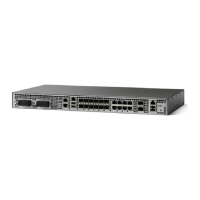52
Cisco IOS XE 3S Release Notes for the Cisco ASR 903 Router
OL-26630-12
Chapter
Caveats in Cisco IOS XE 3.7S Releases
–
The policy is attached to the main interface.
–
The policy classifies on multiple VLANs.
–
The classification statements specify a priority.
–
The classification statements are within a child QoS policy.
Workaround: There is no workaround.
• CSCua96186
Symptom: The router drops cells on a CE-to-CE connection.
Conditions: Occurs with ATM VCC and VPC cell relay mode with 64-byte traffic. The issue occurs
between the ASR 903 and ASR 901 routers.
Workaround: There is no workaround.
• CSCub04699
Symptom: The bandwidth and bandwidth percent commands do not function correctly.
Conditions: Occurs when you configure a service-policy with the priority and police commands in
one class and the bandwidth or bandwidth percent commands in another class.
Workaround: There is no workaround.
• CSCub48081
Symptom: The router does not learn remote MEPs on an EVC bridge-domain MEP following an
interface module reset (soft OIR). The router displays messages indicating object download failure;
the interface status of the xconnect MEP on the peer router displays as administratively down.
Conditions: Occurs when you
–
Configure offloaded EVC xconnect MEP sessions and the sessions are active
–
Configure EVC bridge-domain MEPs
–
Perform a reset (soft OIR) of the Ethernet interface module
Workaround: Remove and restore the local MEP configuration on both routers.
• CSCub55760
Symptom: The router displays a Delay Measurement Message (DMM) delay value of 0.
Conditions: Occurs under the following conditions:
–
You configure an EVC down MEP on a port-channel interface.
–
You dynamically add a member link to a port-channel interface.
Workaround: Configure PTP synchronization before scheduling DMM.
• CSCub60668
Symptom: The router is unable to establish an OSPF session.
Conditions: Occurs when you enable an OSPF session over an MPLS TP tunnel.
Workaround: There is no workaround.
• CSCub69132
Symptom: The OC-3 interface module crashes.
Conditions: Occurs when you issue a soft reload on the OC-3 interface module when the
router is configured with MLPPP at a high scale.
Workaround: There is no workaround.

